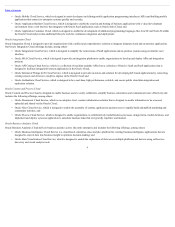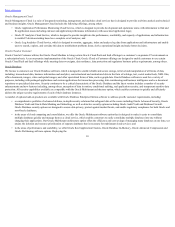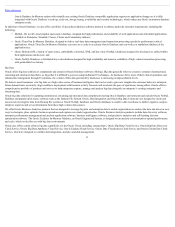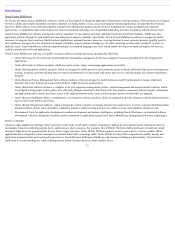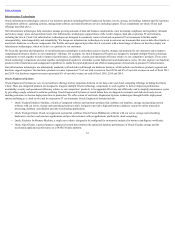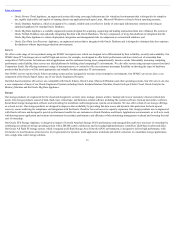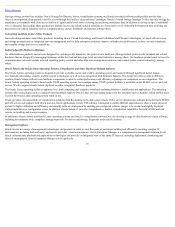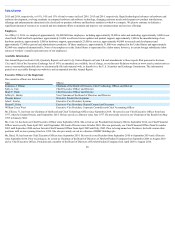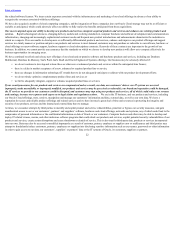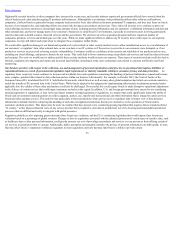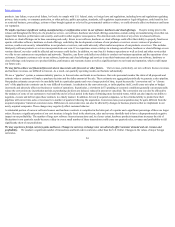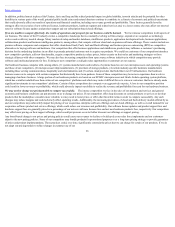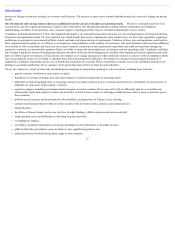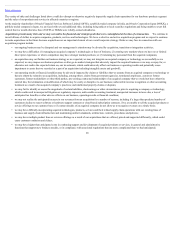Oracle 2015 Annual Report Download - page 21
Download and view the complete annual report
Please find page 21 of the 2015 Oracle annual report below. You can navigate through the pages in the report by either clicking on the pages listed below, or by using the keyword search tool below to find specific information within the annual report.
Table of Contents
• the adoption of commodity servers and microprocessors;
• the broader “platform” competition between our industry standard Java technology platform and the .NET programming environment of Microsoft;
• operating system competition among our Oracle Solaris and Linux operating systems, with alternatives including Microsoft’s Windows Server, and other
UNIX and Linux operating systems;
• the adoption of open source alternatives to commercial software by enterprise software customers;
• products, features and functionality developed internally by customers and their IT staff;
• products, features or functionality customized and implemented for customers by consultants, systems integrators or other third parties; and
• attractiveness of offerings from business processing outsourcers.
For more information about the competitive risks we face, refer to Item 1A. “Risk Factors” included elsewhere in this Annual Report.
Oracle Cloud Operations
Oracle Cloud Operations delivers our SaaS, PaaS and IaaS offerings to customers through the Oracle Cloud, which is a secure, reliable, scalable, enterprise grade
platform that is deployed upon Oracle’s application, platform and infrastructure products and is managed by Oracle employees within a global network of data
centers. The Oracle Cloud enables secure and isolated cloud-based instances for each of our customers to access the functionality of our SaaS, PaaS and IaaS
offerings via a broad spectrum of devices and leverages automated software lifecycle management to enable the rapid delivery of the latest cloud technology
capabilities as they become available.
Manufacturing
To produce our hardware products, we rely on both our internal manufacturing operations as well as third-party manufacturing partners. Our internal manufacturing
operations consist primarily of materials procurement, assembly, testing and quality control of our Oracle Engineered Systems and certain of our enterprise and
data center servers, storage products and networking products. For all other manufacturing, we generally rely on third-party manufacturing partners to produce our
hardware-related components and hardware products and we may involve our internal manufacturing operations in the final assembly, testing and quality control
processes for these components and products. We distribute most of our hardware products either from our facilities or partner facilities. Our manufacturing
processes substantially are based on standardization of components across product types, centralization of assembly and distribution centers and a “build-to-order”
methodology in which products generally are built only after customers have placed firm orders. Production of our hardware products requires that we purchase
materials, supplies, product subassemblies and full assemblies from a number of vendors. For most of our hardware products, we have existing alternate sources of
supply or such sources are readily available. However, we do rely on sole sources for certain of our hardware products. As a result, we continue to evaluate
potential risks of disruption to our supply chain operations. Refer to “Risk Factors” included in Item 1A within this Annual Report for additional discussion of the
challenges we encounter with respect to the sources and availability of supplies for our products and the related risks to our business.
Research and Development
We develop the substantial majority of our product offerings internally. In addition, we have extended our product offerings and intellectual property through
acquisitions of businesses and technologies. We also purchase or license intellectual property rights in certain circumstances. Internal development allows us to
maintain technical control over the design and development of our products. We have a number of United States and foreign patents and pending applications that
relate to various aspects of our products and technology. While we believe that our patents have value, no single patent is essential to us or to any of our principal
business segments. Research and development expenditures were $5.8 billion, $5.5 billion and $5.2 billion in fiscal 2016,
19


